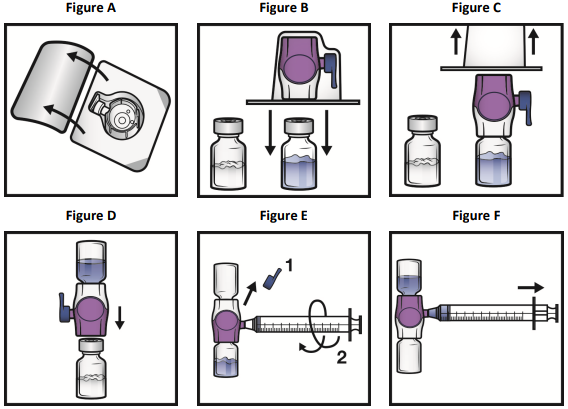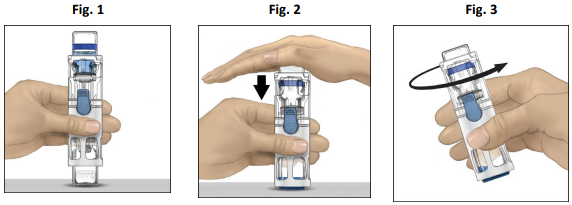ADYNOVATE Powder for injection Ref.[50394] Active ingredients: Coagulation factor VIII
Source: Health Products Regulatory Authority (ZA) Revision Year: 2021 Publisher: ADYNOVATE is distributed in New Zealand by: Takeda New Zealand Limited, Level 10, 21 Queen Street, Auckland 1010, New Zealand, Phone 0508 169 077, www.takeda.com/en-au
4.1. Therapeutic indications
ADYNOVATE, a long-acting antihaemophilic factor (recombinant), is indicated in haemophilia A (congenital factor VIII deficiency) patients for:
- Control and prevention of bleeding episodes
- Routine prophylaxis to prevent or reduce the frequency of bleeding episodes
- Perioperative management (surgical prophylaxis).
ADYNOVATE is not indicated for the treatment of von Willebrand disease.
4.2. Posology and method of administration
Treatment with ADYNOVATE should be under the supervision of a physician experienced in the treatment of haemophilia.
Treatment monitoring
During the course of treatment, appropriate determination of factor VIII levels (by one-stage clotting or chromogenic assays) is advised to guide the dose to be administered and the frequency of repeated infusions. Individual patients may vary in their response to factor VIII, demonstrating different half-lives and recoveries. Dose based on bodyweight may require adjustment in underweight or overweight patients. In the case of major surgical interventions in particular, precise monitoring of the substitution therapy by means of coagulation analysis (plasma factor VIII activity) is indispensable.
Dosage
The dose and duration of the substitution therapy depend on the severity of the factor VIII deficiency, on the location and extent of the bleeding and on the patient’s clinical condition.
The number of units of factor VIII administered is expressed in International Units (IU), which is related to the current WHO concentrate standard for factor VIII products. Factor VIII activity in plasma is expressed either as a percentage (relative to normal human plasma) or preferably in International Units (relative to an International Standard for factor VIII in plasma).
One IU of factor VIII activity is equivalent to that quantity of factor VIII in one mL of normal human plasma.
On demand treatment
The calculation of the required dose of factor VIII is based on the empirical finding that 1IU factor VIII per kg body weight raises the plasma factor VIII activity by 2IU/dL. The required dose is determined using the following formula:
Required units (IU) = body weight (kg) x desired factor VIII rise (%) x 0.5
The amount to be administered and the frequency of administration should always be oriented to the clinical effectiveness in the individual case.
In the case of the following haemorrhagic events, the factor VIII activity should not fall below the given plasma activity level (in % of normal or IU/dl) in the corresponding period.
The following (Table 1) can be used to guide dosing in bleeding episodes and surgery:
Table 1. Guide for dosing in bleeding episodes and surgery:
| Degree of haemorrhage/type of surgical procedure | Factor VIII level required (% or IU/dL) | Frequency of doses (hours)/ duration of therapy (days) |
|---|---|---|
| Haemorrhage | ||
| Early haemarthrosis, muscle bleeding or oral bleeding. | 20-40 | Repeat injections every 12 to 24 hours for at least 1 day, until the bleeding episode, as indicated by pain, is resolved or healing is achieved. |
| More extensive haemarthrosis, muscle bleeding or haematoma. | 30-60 | Repeat injections every 12 to 24 hours for 3-4 days or more until pain and acute disability are resolved. |
| Life threatening haemorrhages. | 60-100 | Repeat injections every 8 to 24 hours until threat is resolved. |
| Surgery | ||
| Minor Including tooth extraction. | 30-60 | Every 24 hours (12 to 24 hours for patients under the age of 6), at least 1 day, until healing is achieved. |
| Major | 80-100 (pre- and postoperative) | Repeat injections every 8 to 24 hours (6 to 24 hours for patients under the age of 6) until adequate wound healing then continue therapy for at least another 7 days to maintain a factor VIII activity of 30% to 60% (IU/dL). |
Prophylaxis
For long term prophylaxis, the recommended dose is 40 to 50 IU per kg bodyweight of ADYNOVATE twice weekly in 3 to 4 day intervals. Dose and/or frequency should be adjusted to provide the necessary coverage to prevent bleeding. In some cases, doses up to 60IU per kg can be used.
Paediatric population
On demand treatment dosing in paediatric patients (0 to < 12 years of age) does not differ from adult patients. Higher doses or more frequent dosing may be required in some children.
For prophylactic therapy in patients under the age of 12, the recommended dose is 40 to 60IU per kg bodyweight of ADYNOVATE twice weekly in 3 to 4 day intervals. In some cases, doses up to 80IU per kg can be used.
Method of administration
ADYNOVATE should be administered via the intravenous route.
ADYNOVATE should be administered at room temperature not more than 3 hours after reconstitution.
Reconstituted products should be visually inspected for particulate matter and discolouration prior to administration. The solution should be clear to colourless. Do not administer if particulate matter or discolouration or cloudiness is found.
ADYNOVATE does not contain antimicrobial preservative. It is for single use in one patient only. Discard any residue.
The rate of administration should be determined to ensure the comfort of the patient up to a maximum of 10mL/min.
After reconstitution, the solution is clear, colourless, free from foreign particles and has a pH of 6.7 to 7.3. The osmolality is ≥ 380m Osmol/kg.
For instructions on reconstitution of ADYNOVATE powder for injection, before administration, see section 6.6.
Administration
- Visually inspect the reconstituted ADYNOVATE solution for particulate matter and discolouration prior to administration.
- The appearance of ADYNOVATE is clear and colourless.
- Do not use if particulate matter or discolouration is observed.
- Administer ADYNOVATE as soon as possible, but no later than 3 hours after reconstitution.
Administration Steps
- Remove the blue cap from the BAXJECT II HI-FLOW/BAXJECT III device. Connect the syringe to the BAXJECT II HI-FLOW/BAXJECT III device. Use of a Luer-lock syringe is recommended. Do not inject air.
- Turn the system upside down (ADYNOVATE vial now on top). Draw the factor concentrate into the syringe by pulling the plunger back slowly.
- Disconnect the syringe; attach a suitable needle and inject intravenously. If a patient is to receive more than one vial of ADYNOVATE, the contents of multiple vials may be drawn into the same syringe. A separate BAXJECT II HI-FLOW device is required to reconstitute each vial of ADYNOVATE with the diluent.
- Administer ADYNOVATE over a period of less than or equal to 5 minutes (maximum infusion rate 10 mL per min).
4.9. Overdose
There has been no reported clinical adverse experience that could be associated with overdosage.
For advice on the management of overdose please contact the National Poisons Centre on 0800 POISON (0800 764 766).
6.3. Shelf life
2 years.
6.4. Special precautions for storage
Store ADYNOVATE in powder form at 2°C to 8°C. Do not freeze.
ADYNOVATE may be stored at room temperature not to exceed 30°C for a period of up to 3 months not to exceed the expiration date. If stored at room temperature, write the date on the carton when ADYNOVATE is removed from refrigeration.
After storage at room temperature, do not return the product to the refrigerator.
Do not use beyond expiration date printed on the carton or vial.
Store vials in their original box and protect them from extreme exposure to light.
After reconstitution, do not refrigerate the solution. Use the reconstituted solution immediately or within 3 hours after reconstitution. Discard any remaining solution.
6.5. Nature and contents of container
Each pack contains a powder vial and a vial containing 2mL or 5mL diluent (both type I glass closed with chlorobutyl rubber stoppers). The product is supplied in either one of the following configurations:
- ADYNOVATE with BAXJECT II HI-FLOW device: Each pack contains a powder vial, a vial containing diluent and a device for reconstitution (BAXJECT II HI-FLOW).
- ADYNOVATE in BAXJECT III system: Each pack contains a ready to use BAXJECT III system in a sealed blister (the powder vial and the vial containing diluent are preassembled with the system for reconstitution).
Not all pack sizes may be marketed.
6.6. Special precautions for disposal and other handling
Any unused product or waste material should be disposed of in accordance with local requirements.
After reconstitution, the solution is clear, colourless, free from foreign particles and has a pH of 6.7 to 7.3. The osmolality is ≥380m Osmol/kg.
Preparation and reconstitution
Use aseptic technique.
Using the BAXJECT II HI-FLOW Device
For reconstitution use only the sterilised water for injections and the reconstitution device provided in the pack.
- Use aseptic technique (clean and germ free) and a flat work surface during the reconstitution procedure.
- Allow the vials of ADYNOVATE and diluent to reach room temperature before use.
- Remove plastic caps from the ADYNOVATE and diluent vials.
- Cleanse rubber stoppers with an alcohol wipe and allow to dry prior to use.
- Open the BAXJECT II HI-FLOW device package by peeling away the lid, without touching the inside (Figure A). Do not remove the device from the package.
- Turn the package over. Press straight down to fully insert the clear plastic spike through the diluent vial stopper (Figure B).
- Grip the BAXJECT II HI-FLOW package at its edge and pull the package off the device (Figure C). Do not remove the blue cap from the BAXJECT II HI-FLOW device. Do not touch the exposed purple plastic spike.
- Turn the system over so that the diluent vial is on top. Quickly insert the purple plastic spike fully into the ADYNOVATE vial stopper by pushing straight down (Figure D). The vacuum will draw the diluent into the ADYNOVATE vial.
- Swirl gently until ADYNOVATE is completely dissolved. Do not refrigerate after reconstitution.
Using the BAXJECT III system
Do not use if the lid is not completely sealed on the blister.
- If the product is still stored in a refrigerator, take the sealed blister (contains powder and diluent vials preassembled with the system for reconstitution) from the refrigerator and let it reach room temperature
- Wash your hands thoroughly using soap and warm water.
- Open the ADYNOVATE package by peeling away the lid. Remove the BAXJECT III system from the blister.
- Place ADYNOVATE on a flat surface with the diluent vial on top (Fig. 1). The diluent vial has a blue stripe. Do not remove the blue cap until instructed in a later step.
- With one hand holding ADYNOVATE in the BAXJECT III system, press down firmly on the diluent vial with the other hand until the system is fully collapsed and the diluent flows down into the ADYNOVATE vial (Fig. 2). Do not tilt the system until the transfer is complete.
- Verify that the diluent transfer is complete. Swirl gently until all material is dissolved. Be sure that the ADYNOVATE powder is completely dissolved, otherwise not all reconstituted solution will pass through the device filter. The product dissolves rapidly (usually in less than 1 minute). After reconstitution the solution should be clear, colourless and free from foreign particles.
© All content on this website, including data entry, data processing, decision support tools, "RxReasoner" logo and graphics, is the intellectual property of RxReasoner and is protected by copyright laws. Unauthorized reproduction or distribution of any part of this content without explicit written permission from RxReasoner is strictly prohibited. Any third-party content used on this site is acknowledged and utilized under fair use principles.

